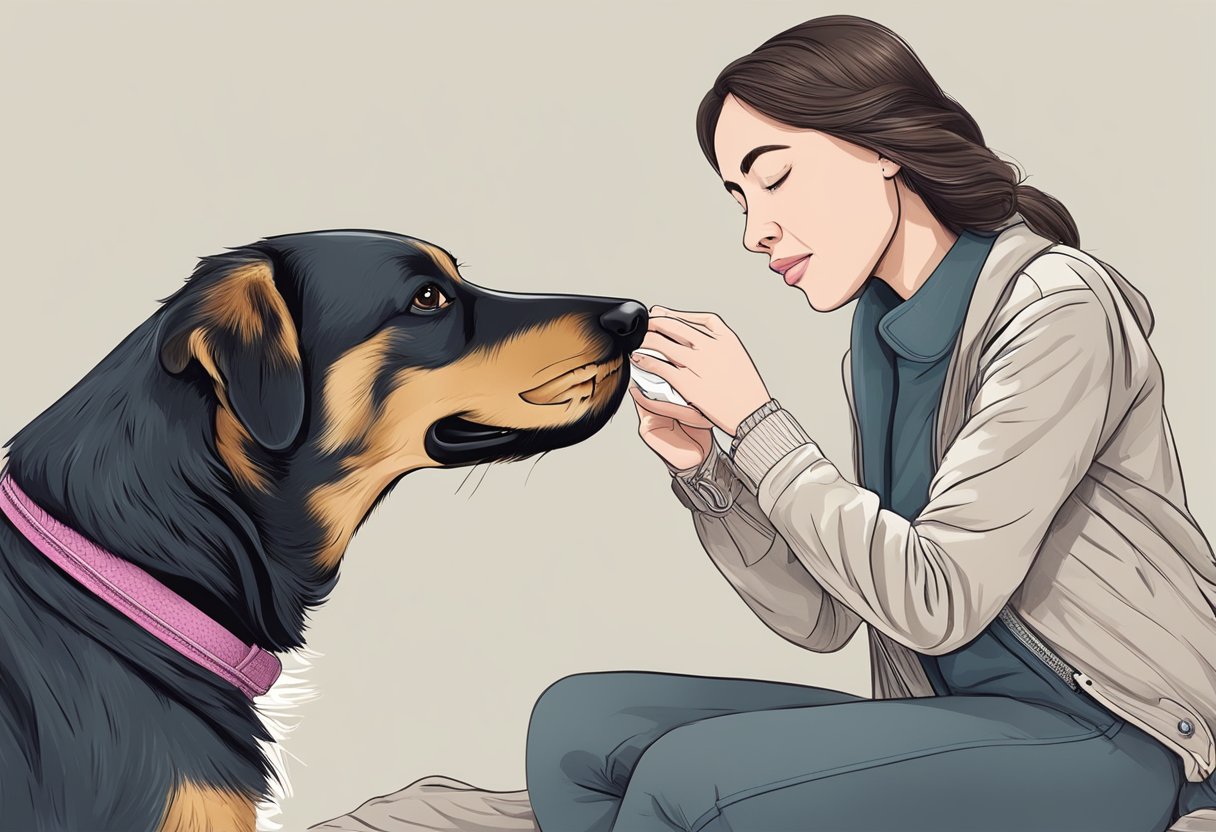Many pet owners have anecdotally reported that their canine companions behave differently around them when they are menstruating, suggesting that dogs may be able to sense when a person is on their period. This sensory ability is attributed to dogs’ remarkable sense of smell, which is vastly superior to that of humans. It is hypothesized that dogs pick up on hormonal changes in a person’s body through pheromones present during menstruation.
While there is limited scientific research explicitly addressing whether dogs can sense menstruation, there are indications that their olfactory prowess allows them to detect variations in human hormonal levels. Observations of alterations in a dog’s behavior—such as increased clinginess or attentiveness—during their owner’s menstrual cycle further fuel these beliefs, hinting at a canine’s ability to perceive biological changes through scent.
Key Takeaways
- Dogs may detect hormonal changes associated with menstruation due to their advanced olfactory senses.
- Behavioral changes in dogs might signal their response to pheromones released by humans during a menstrual cycle.
- Understandings from anecdotal observations suggest that dogs react to menstrual scent cues, although concrete scientific evidence is sparse.
Canine Olfactory Capabilities

Dogs possess a remarkably acute sense of smell, capable of detecting minute chemical signals, including hormonal changes in humans. This sophisticated olfactory system allows them not only to pick up scents that are completely undetectable to humans but also to distinguish between a wide array of distinct odors.
Acute Sense of Smell
Dogs have an acute sense of smell that is significantly more sensitive than that of humans. The average dog can have up to 300 million olfactory receptors in their noses, compared to about six million in humans. For certain breeds like Bloodhounds, the number of scent receptors can be even higher, enhancing their ability to detect and follow scents.
Scent Recognition Abilities
Canines can recognize and remember a vast range of scents. This stems from their ability to detect the specific chemical compositions of odors through their olfactory receptors. Their scent recognition abilities play an essential role in communication, hunting, and identification tasks.
Understanding Dog’s Sense Around Menstruation
Dogs may detect the scent of pheromones produced by menstruating women. These pheromones, emanated by the apocrine glands, communicate reproductive status among many species and can subtly alter a dog’s behavior due to their keen sense of smell.
Biological Responses to Hormonal Changes
The reaction of dogs to human hormonal changes, such as those occurring during the menstrual cycle, may be attributed to their biological responses to hormonal changes. They can pick up on these hormonal shifts through scent, as they have evolved to sense pheromones and other chemical signals.
Impact of a Dog’s Breed on Scent Detection
While all dogs have advanced olfactory senses, scent hounds like Bloodhounds, Basset Hounds, and Beagles have a heightened ability to detect odors. These breeds possess a greater number of olfactory receptors, which makes them especially effective in scent-related work, such as tracking and search and rescue operations.
Dogs Sensing Other Health-Related Changes
Dogs can detect various health-related changes in a human. Their ability to sense is so precise that they have been trained to sniff out illnesses, such as cancer or migraines, by recognizing the unique chemical signals emitted by the body during these illnesses. Their role in forensic investigations is also evolving due to this unparalleled olfactory capacity.
Behavioral Indicators of Dogs Sensing Menstruation

Dogs exhibit discernible alterations in behavior in response to their owner’s menstrual cycle due to their acute sense of smell. These changes range from subtle shifts in demeanor to more overt physical reactions and behaviors aimed at providing comfort or exhibiting protectiveness.
Changes in Dog’s Behavior
During menstruation, dogs may exhibit behavioral changes such as increased clinginess or attention-seeking behaviors. Owners often notice their dogs becoming more affectionate or insistent on being near them, possibly due to the canine’s ability to sniff out the hormonal changes that occur during this period.
Physical Reactions to Menstrual Scent
Dogs have an excellent ability to detect scents and may lick or sniff at their owner’s crotch area more frequently. They might also show interest in menstrual products like tampons or pads due to the scent of menstrual blood they can detect.
Comfort Providing Behavior
Many dogs respond to the perceived increase in stress or anxiety in their menstruating owners by offering comfort or reassurance. Some dogs may initiate cuddling more often or stay closer to their owners as a means of providing support.
Protective and Territorial Responses
Along with comfort-driven behaviors, dogs may also become more protective or display signs of territorialism. There have been observations of some dogs exhibiting aggression or dominance when strangers approach their menstruating owner, potentially triggered by the distinct hormonal scents.
Impact of Menstruation on Dog’s Routine
A dog’s regular routine can be subtly or overtly disrupted by their owner’s menstrual cycle. This disruption is often reflected in altered walk times, feeding schedules, or play sessions as the dog adjusts its behavior to stay close and attentive to the menstruating owner.
How Dog Owners Can Manage Their Dogs During Their Period

During a woman’s menstrual cycle, dogs may display different behaviors due to their ability to detect scent changes. Dog owners can manage these behaviors by creating a supportive environment and maintaining consistent training and hygiene practices.
Maintaining a Calming Environment
Creating a calm environment helps reduce stress for dogs who may become more anxious or stressed when detecting hormonal changes. Using pheromone diffusers and ensuring a quiet and stable home setting can help keep dogs at ease.
Adapting Training and Attention
Consistency in training and providing attention are key. During this time, stick to routine training sessions with positive reinforcement. If the dog becomes overly clingy, dog owners may need to gently reinforce personal space boundaries.
Dealing with Unwanted Behaviors
If a dog exhibits unwanted behaviors such as becoming overly aggressive or attempting to hump, redirect these actions using structured training techniques. Consultation with a professional dog trainer may be beneficial for managing these issues.
Ensuring Proper Hygiene Practices
Minimize attraction to the menstrual scent by disposing of tampons and pads in a manner that prevents dogs from accessing them, such as using trash cans with secure lids. Regularly clean areas where the dog spends time to keep the environment free of bacteria and excess scent.
Providing Care and Attention
Understanding a dog’s need for care and attention during a potentially confusing time is important. Extra comfort can be provided through more cuddle time, gentle petting, or a cozy space for the furry friend to feel secure with their canine companion.
Considerations Beyond Menstruation

Beyond the ability to detect menstrual odors, dogs exhibit impressive capacities to sense various biological and emotional states in humans. These abilities extend to recognizing changes in fertility and reproductive status, as well as responding to emotional fluctuations and other physical conditions.
Sensing Fertility and Reproductive Status
Dogs’ acute sense of smell enables them to detect pheromones, which are chemical signals related to fertility and reproductive status. These olfactory cues are not limited to menstruation; they can also indicate stages of the menstrual cycle and potentially even pregnancy, due to the different hormonal changes that occur.
Detecting Emotions and Other Physical Changes
In addition to hormonal changes, dogs are attuned to emotional states like stress, fear, joy, and surprise. Heightened emotions can lead to the release of additional pheromones and changes in scent, which dogs may perceive. This sensitivity to emotions can manifest as a dog becoming more clingy or distant when its owner is experiencing anxiety or stress.
Other Animals and Menstrual Scent
While dogs are known for their remarkable sense-detecting abilities, other animals such as cats and rodents may also react to menstrual scents. However, their responses can differ due to varying levels of olfactory receptors and their natural behaviors and communication methods. Like dogs, these animals may respond to the pheromones that indicate reproductive status and changes in their environment.
Frequently Asked Questions

This section addresses common inquiries regarding canines’ reactions to hormonal changes in humans, with a focus on menstruation and pregnancy.
What behaviors might dogs exhibit if they detect a change in a person’s hormonal levels?
Dogs may show a variety of behaviors, such as increased sniffing, clinginess, and a heightened curiosity when they sense a change in a person’s hormonal levels.
How might a dog’s behavior change towards a pregnant owner?
During pregnancy, a dog may become more protective and attentive towards their owner as they detect hormonal changes associated with pregnancy.
Why might a dog act more protective or clingy during their owner’s menstrual cycle?
Dogs might act more protective or clingy during their owner’s menstrual cycle in response to detecting the hormonal changes, which could be interpreted by the dog as a change in their owner’s well-being.
Can the keen sense of smell in dogs pick up on changes in a person’s body chemistry?
Yes, dogs have a keen sense of smell and can detect even subtle changes in a person’s body chemistry, including those that occur during a menstrual cycle.
What are some possible behaviors in cats when their owner is menstruating?
While less is known about cats in this context, some may exhibit changes in behavior such as being more affectionate or more demanding of attention when their owner is menstruating.
How do pets, in general, react to their human’s physical or emotional pain?
Pets may react to their human’s physical or emotional pain by being more attentive, staying closer to their owner, or showing signs of distress themselves. They are often sensitive to shifts in their owner’s mood and behavior.
